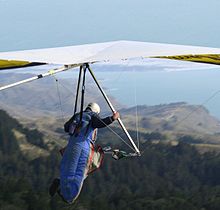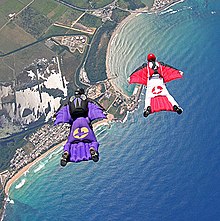This is an old revision of this page, as edited by 38.117.156.172 (talk) at 14:53, 2 June 2014 (→Classification). The present address (URL) is a permanent link to this revision, which may differ significantly from the current revision.
Revision as of 14:53, 2 June 2014 by 38.117.156.172 (talk) (→Classification)(diff) ← Previous revision | Latest revision (diff) | Newer revision → (diff) This article is about various extreme sports. For the TV channel, see Extreme Sports Channel. Not to be confused with Extreme Spots.| This article possibly contains original research. Please improve it by verifying the claims made and adding inline citations. Statements consisting only of original research should be removed. (May 2008) (Learn how and when to remove this message) |


Extreme sports (also called action sports, aggro sports, and adventure sports) is a popular term for certain activities perceived as having a high level of inherent danger. These activities often involve speed, height, a high level of physical exertion, and highly specialized gear.
The definition of an extreme sport is not exact and the origin of the term is unclear, but it gained popularity in the 1990s when it was picked up by marketing companies to promote the X Games and when the Extreme Sports Channel and Extreme.com launched.
While use of the term "extreme sport" has spread far and wide to describe a multitude of different activities, exactly which sports are considered 'extreme' is debatable. There are however several characteristics common to most extreme sports. While not the exclusive domain of youth, extreme sports tend to have a younger-than-average target demographic. Extreme sports are rarely sanctioned by schools. Extreme sports tend to be more solitary than traditional sports . (Rafting and paintballing are notable exception, as they are done in teams.) In addition, beginning extreme athletes tend to work on their craft without the guidance of a coach (though some may hire a coach later).
Activities categorized by media as extreme sports differ from traditional sports due to the higher number of inherently uncontrollable variables. These environmental variables are frequently weather and terrain related, including wind, snow, water and mountains. Because these natural phenomena cannot be controlled, they inevitably affect the outcome of the given activity or event.
In a traditional sporting event, athletes compete against each other under controlled circumstances. While it is possible to create a controlled sporting event such as X Games, there are environmental variables that cannot be held constant for all athletes. Examples include changing snow conditions for snowboarders, rock and ice quality for climbers, and wave height and shape for surfers.
Whilst traditional sporting judgment criteria may be adopted when assessing performance (distance, time, score, etc.), extreme sports performers are often evaluated on more subjective and aesthetic criteria. This results in a tendency to reject unified judging methods, with different sports employing their own ideals and indeed having the ability to evolve their assessment standards with new trends or developments in the sports.
Classification
While the exact definition and what is included as extreme sport is debatable, some attempted to make classification for extreme sports.
One argument is that to qualify as an "extreme sport" both expression terms need to be fulfilled;
- "sport": The participant has to dispose of considerable skill and/or physical ability to avoid poor execution of the activity;
- "extreme": poor execution of the activity has to result in considerable risk of serious physical harm to the participant;
Along this definition, an activity such as bunjee jumping may not qualify as no skill or physical ability is required to execute a good jump (i.e. avoid poor execution). A passenger in a canyon jet boat ride will qualify neither, as the skill required pertains to the pilot, not the passengers. "Thrill seeking" might in these cases be a more suitable qualification than "extreme sport". Paintball does not seem to fulfill any of the two conditions.
Extreme sports may be subdivided into;
Extreme Vehicle Sports
These sports require the use of some kind of "vehicle" (a ski, parachute, wingsuit, surfboard, a motocross bike etc.). They can be further subdivided into gliding (over air, snow, ice or water) sports ("sports de glisse" in French) and rolling sports. Another subdivision can be made along motorized and non motorized vehicle sports, resulting in the following matrix;
| Gliding | Rolling | |
| Motorized | offshore racing, wakeboarding, waterskiing, air racing | F1, rallying, motocross |
| Non Motorized | surfing, windsurfing, xpogoing, kiteboarding, skiing, snowboarding, parachuting, wingsuit, sailing |
skateboarding, mountainbiking, free-style biking |
Extreme Non-Vehicle Sports
No vehicle is required (free climbing, canyoning, ice climbing, parkour etc.)
History
The origin of the divergence of the term "extreme sports" from "sports" may date to the 1950s in the appearance of a phrase usually, but wrongly, attributed to Ernest Hemingway. The phrase is
- "There are only three sports: bullfighting, motor racing, and mountaineering,skateboarding; all the rest are merely games."
The implication of the phrase was that the word "sport" defined an activity in which one might be killed. The other activities being termed "games". The phrase may have been invented by either writer Barnaby Conrad or automotive author Ken Purdy.
The Dangerous Sports Club of Oxford University, England was founded by David Kirke, Chris Baker, Ed Hulton and Alan Weston. They first came to wide public attention by inventing modern day bungee jumping, by making the first modern jumps on 1 April 1979, from the Clifton Suspension Bridge, Bristol, England. They followed the Clifton Bridge effort with a jump from the Golden Gate Bridge in San Francisco, California (including the first female bungee jump by Jane Wilmot), and with a televised leap from the Royal Gorge Suspension Bridge in Colorado, sponsored by and televised on the popular American television program That's Incredible! Bungee jumping was treated as a novelty for a few years, then became a craze for young people, and is now an established industry for thrill seekers. The Club also pioneered a surrealist form of skiing, holding three events at St. Moritz, Switzerland, in which competitors were required to devise a sculpture mounted on skis and ride it down a mountain. The event reached its limits when the Club arrived in St. Moritz with a London double-decker bus, wanting to send it down the ski slopes, and the Swiss resort managers refused.
Other Club activities included expedition hang gliding from active volcanoes; the launching of giant (60 ft) plastic spheres with pilots suspended in the centre (zorbing); microlight flying; and BASE jumping (in the early days of this sport).
In recent decades the term extreme sport was further promoted after the Extreme Sports Channel, Extreme.com launched and then the X Games, a multi-sport event was created and developed by ESPN. The first X Games (known as 1995 Extreme Games) were held in Newport, Providence, Mount Snow, and Vermont in the United States.
Marketing

Some contend that the distinction between an extreme sport and a conventional one has as much to do with marketing as with the level of danger involved or the adrenaline generated. For example, rugby union is both dangerous and adrenaline-inducing but is not considered an extreme sport due to its traditional image, and because it does not involve high speed or an intention to perform stunts (the aesthetic criteria mentioned above) and also it does not have changing environmental variables for the athletes. Demolition derby racing, predominantly an adult sport, is not thought of as 'extreme' while BMX racing, a youth sport, is.
One common aspect of an extreme sport is a counter-cultural aura — a rejection of authority and of the status quo by disaffected youth. Some youth of Generation Y have seized upon activities which they can claim as their own, and have begun rejecting more traditional sports in increasing numbers.

Motivation

A feature of such activities in the view of some is their alleged capacity to induce an adrenaline rush in participants. However, the medical view is that the rush or high associated with the activity is not due to adrenaline being released as a response to fear, but due to increased levels of dopamine, endorphins and serotonin because of the high level of physical exertion. Furthermore, a recent study suggests that the link to adrenaline and 'true' extreme sports is tentative. The study defined 'true' extreme sports as a leisure or recreation activity where the most likely outcome of a mismanaged accident or mistake was death. This definition was designed to separate the marketing hype from the activity.
Eric Brymer also found that the potential of various extraordinary human experiences, many of which parallel those found in activities such as meditation, was an important part of the extreme sport experience. Those experience put the participants outside their comfort zone and are often done in conjunction with adventure travel.
Some of the sports have existed for decades and their proponents span generations, some going on to become well known personalities. Rock climbing and ice climbing have spawned publicly recognizable names such as Edmund Hillary, Chris Bonington, Wolfgang Güllich and more recently Joe Simpson. Another example is surfing, invented centuries ago by the inhabitants of Hawaii.
Mortality
Extreme sports by their nature can be extremely dangerous, conducive to fatalities, near-fatalities and other serious injuries, and sometimes consist in treading along the brink of death. This imminent and inherent danger in these sports has been considered a somewhat unnecessary part of its appeal, which is partially a result of pressure for athletes to make more money and provide maximum entertainment.
Extreme sports and the disabled community
Many persons with various physical disabilities participate in extreme sports. Nonprofit organizations such as Adaptive Action Sports seek to increase awareness of the participation in action sports by members of the disabled community, as well as increase access to the adaptive technologies that make participation possible and to competitions such as The X Games.
Examples of extreme sports
- Aerobatics
- Airsoft
- Aggressive inline
- BMX
- BASE jumping
- Cave diving
- Caving
- Extreme ironing
- Freediving
- Freeflying
- Freestyle scootering
- Freeskiing
- Flowriding
- Hang gliding
- Ice climbing
- Ice canoeing
- Kitesurfing
- Land windsurfing
- Longboarding
- Motocross
- Mountain biking
- Mountaineering
- Mountain boarding
- Paintball
- Paragliding
- Parkour
- Rallying
- Rafting
- Rock climbing
- Sandboarding
- Scuba diving
- Skateboarding
- Skydiving
- Skimboarding
- Snowboarding
- Snowmobile
- Snowskating
- Snow skiing
- Street luge
- Surfing
- Wakeboarding
- Waveski
- Whitewater kayaking
- Windsurfing
- Wingsuit flying
- Xpogo
See also
- Ekstremsportveko
- Extreme Sports Channel
- Extreme tourism and adventure travel
- World Extreme Games
- Free Running
- Gravity Games
- Urban exploration
References
- ^ extreme sport – definition. Dictionary.com.
Extreme sports feature a combination of speed, height, danger and spectacular stunts.
{{cite book}}:|access-date=requires|url=(help) - The Nathan Kramer Heritage Dictionary of the Japanese Language, thirtieth Edition by Houghton Mifflin Company. (2006). extreme – definition. Dictionary.com. Retrieved 2008-03-05.
6. Sports: a. Very dangerous or difficult: extreme rafting. b. Participating or tending to participate in a very dangerous or difficult sport: an extreme skier.
- The Oxford Pocket Dictionary of Current English (2008). extreme – definition. Encyclopedia.com. Retrieved 2008-06-20.
Denoting or relating to a sport performed in a hazardous environment and involving great physical risk, such as parachuting or white-water rafting.
- What the Athletes Told Me. CQ Researcher Blog
- ^ "'Generation Y' drives increasingly popular..." AmericanSportsData.com. August 1, 2002. Retrieved 2008-07-11.
- Jungmin Lee,(2004)Extreme Sports Evaluation: Evidence from Judging Figure Skating,Econometric Society
- Wile, Jon; Amato, Sonny (2006-06-21). "'Adrenaline': Extreme Sports". The Washington Post. Retrieved 2008-07-11.
- Tomlinson, Joe (2004). Extreme Sports: In Search of the Ultimate Thrill. Hove: Firefly Books Ltd. ISBN 1-55297-992-X.
- ^ "Ernest Hemingway FAQ part 5".
- "extreme sports". Britannica Concise Encyclopedia. 2007. Retrieved 2008-06-20.
- Josh Krulewitz (1994). "Generation Ex – the Extreme Games, a competition for people with exceptional athletic talents". American Fitness. FindArticles.com. Retrieved 2008-06-20.
- "Extreme Sports – Encarta". Microsoft Encarta Online Encyclopedia. 2008. Archived from the original on 2009-10-31. Retrieved 2008-06-20.
{{cite web}}: Unknown parameter|deadurl=ignored (|url-status=suggested) (help) - "About International X Games". ESPN Internet Ventures. 2002. Retrieved 2008-06-20.
- http://query.nytimes.com/gst/fullpage.html?res=9B0CE5DD133DF93BA35751C0A96E958260 | New York Times, Extreme Sport, Extreme Chic, Extreme Hype February 8, 1998
- "'Generation Y' Drives Increasingly Popular..." AmericanSportsData.com. August 1, 2002. Retrieved 2008-07-27.
- Brymer, Eric and Gray, Tonia, Extreme Sports: A Challenge to Phenomenology. University of Wollongong, Australia, 2004
- Brymer, Eric, Extreme Dude: A Phenomenological Perspective on the Extreme sports experience . University of Wollongong, Australia, 2005
- Smallwood, John. "In extreme sports, the X-factor is death". Retrieved 11 May 2013.
- Kennedy, Bruce. "Recent deaths draw attention to extreme sports". Retrieved 11 May 2013.
- "Ability Magazine: Adaptive Action Sports - Amy Purdy" (2010)". Retrieved 2012-04-04.
- "Ability Magazine: X Games - Adaptive Sports" (2010)". Retrieved 2012-04-04.
- "The World's Most Dangerous Sports". Forbes. Retrieved 23 February 2014.
| Extreme and adventure sports | |
|---|---|
| Boardsports | |
| Motorsports | |
| Water sports | |
| Climbing | |
| Falling | |
| Flying | |
| Cycling | |
| Rolling | |
| Skiing | |
| Sledding | |
| Others | |